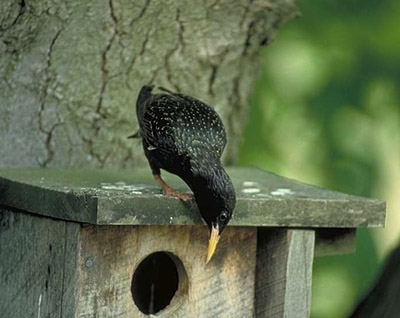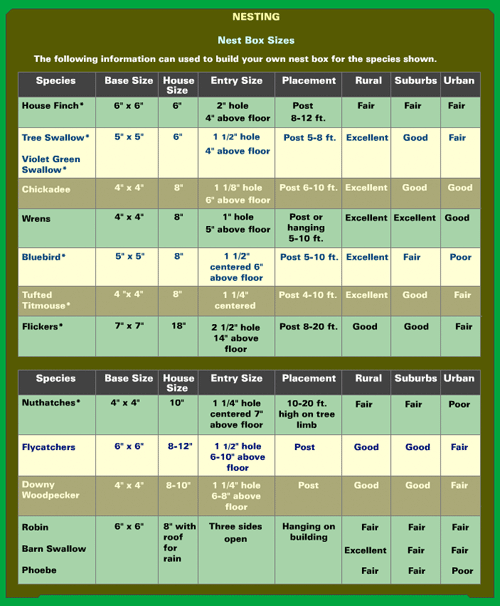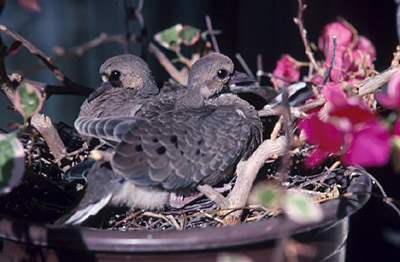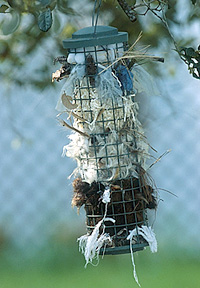
Building your own bird est box can be a fun family project. Almost any type of lumbar can be used, as long as it is untreated. A good choice is cedar or fur, both of which weather well.
Each species shows has a favored box and hole size. Do not be too concerned, however, if your next box is not perfect. The birds do not use rulers and natural cavities are not perfect sizes.
Bird Nest Box Sizes
| Species | Base Size | House Size | Entry Size | Placement | Rural | Suburbs | Urban |
| House Finch | 6″ x 6″ | 6″ | 2″ hole, 4″ above floor | Post 8-12 ft. | Fair | Fair | Fair |
| Tree Swallow | 5″ x 5″ | 6″ | 1 1/2″ hole 4″ above floor | Post 5-8 ft. | Excellent | Good | Fair |
| Violet Green Swallow | 5″ x 5″ | 6″ | 1 1/2″ hole 4″ above floor | Post 5-8 ft. | Excellent | Good | Fair |
| Chickadee | 4″ x 4″ | 8″ | 1 1/8″ hole 6″ above floor | Post 6-10 ft. | Excellent | Good | Good |
| Wrens | 4″ x 4″ | 8″ | 1″ hole 5″ above floor | Post or hanging 5-10 ft. | Excellent | Excellent | Good |
| Bluebird | 5″ x 5″ | 8″ | 1 1/2″ centered 6″ above floor | Post 5-10 ft. | Excellent | Fair | Poor |
| Tufted Titmouse | 4″ x 4″ | 8″ | 1 1/4″ centered | Post 4-10 ft. | Excellent | Good | Fair |
| Flickers | 7″ x 7″ | 18″ | 2 1/2″ hole 14″ above floor | Post 8-20 ft. | Good | Good | Fair |
| Species | Base Size | House Size | Entry Size | Placement | Rural | Suburbs | Urban |
| Nuthatches | 4″ x 4″ | 10″ | 1 14″ hole centered 7″ above floor | 10-20 ft high on tree limb | Fair | Fair | Poor |
| Flycatchers | 6″ x 6″ | 8-12″ | 1 1/2″ hole 6-10″ above floor | Post | Good | Good | Fair |
| Downy Woodpecker | 4″ x 4″ | 8-10″ | 1 1 /4″ hole 6-8″ above floor | Post | Good | Good | Fair |
| Robin | 6″ x 6″ | 8″ with roof for rain | Three sides open | Hanging on a building | Fair | Fair | Fair |
| Barn Swallow | 6″ x 6″ | 8″ with roof for rain | Three sides open | Hanging on a building | Excellent | Fair | Fair |
| Phoebe | 6″ x 6″ | 8″ with roof for rain | Three sides open | Hanging on a building | Fair | Fair | Poor |
Importance of Nest Boxes
Nest boxes are important for several reasons, but the one that stands out the most is security. We all want to feel safe in our homes, and birds are no different. The size of the nest box determines how well it can protect the birds from predators. A larger nest box may not provide enough protection from predators, while a smaller one may not provide enough space for the birds to feel secure. The right entry size is important so that other birds could not enter.
In general, a nest box should be sized appropriately for the bird species you are trying to attract. Providing the right size and type of nest box can increase the chances of attracting birds to your yard and successfully breeding and raising young.

The thought of spring immediately brings visions of trees budding, fresh rains, and all that is associated with the rebirth of the natural world. Springtime can be the best season of the year for backyard bird watchers.
Birds are at their peak when it comes to activity and behavior. During no other time of the year are birds more enticing. They flit around yards and frequent feeders in full breeding plumage. Their behavior can hold a birders’ interest for hours.
Cardinals perched high in treetops singing to attract a mate can bring an evening to life as you listen to the song. Chickadees fill the oak trees and the air with their chatter. These exciting colorful little creatures have only one thing on their minds in spring: reproduction. These wonderfully animated entertainers will remain in your backyard and provide enjoyment for many more weeks to come. By simply adding a few items you can help make nesting easier.
Too lazy to build your own? See the best birdhouses (that are on the market at the moment)
Housing
The world changes everyday. Demand for habitat increases daily, as more trees, shrubs and forest land is being cleared around the country.
What was once a bird’s home is now a vacant lot or strip mall. It is amazing how much success the backyard birder can have with a little work and proper planning. Placing a few birdhouses in the backyard along with food and water can make a great deal of difference for our feathered friends.
An added benefit is the pleasure of watching courtship, nest building, and eventually seeing the fledglings leave the nest.

Mourning doves will nest in a variety of locations, including hanging flower pots.
Who’s in the neighborhood?
Before rushing out to buy birdhouses, it is necessary to consider a few things. Find out what birds frequent your area. Contact the local Audubon society or observe birds that are already in your yard to learn more about the birds that nest in your area. Once you have a species list for your geographic region, a search for appropriate housing can begin.
Different size birds require different size houses, openings, and prefer their houses to be located at different heights from the ground. Some birds prefer houses hanging from tree limbs, others want their houses secured to posts, and in some cases even color plays a role in the ability to attract birds to the nest box.
It is essential to keep in mind the type of habitat that is available to work with. There would be no need putting a bluebird box out if you live in a downtown setting surrounded by trees. To effectively attract birds to nest in the backyard the landlord needs to be bird specific when putting out potential houses.
For more information we have included a summary of nesting boxes that tells the size house, opening, placement and habitat one would need to attract birds to nest in the backyard (link on the left).
The chances for attracting birds will be much better if the birdhouse is set up in the fall. That new look will take on a more weathered appearance by spring and make it more attractive to the birds once nesting season arrives. Birds need shelter in the winter months and can move in early if the weather becomes too grueling.
Manage your house
Starlings and sparrows are always in search of prime real estate. Birdhouses are easy targets for these introduced foreign species and many native species will go without nesting sites in the wild due to these birds. Evicting starlings and sparrows is essential to success.
These species can be relentless in trying to move in. The kind hearted may have a difficult time evicting the unwanted bird. Keep in mind if the landlord does not take action allowing these birds to claim residence can eliminate the chances for attracting native birds that need the nesting site the most.

European Starling checking out a nesting box. Starlings and House Sparrows should be quickly evicted if they try to move in.
Natural is better
Many people use birdhouses as decorative additions to their gardens. While a pretty coat of brightly colored paint may appeal to the gardener, birds actually prefer a more natural look. Purple martins want houses painted white with a little mud smeared on the interior to make them feel even more at home. Nuthatches want a bark exterior, and some birds are more accommodating and want only a plain brown wooden exterior.
Another easy and attractive man-made nesting container is the hanging potted plant. Hanging baskets, both planted or un-planted, will provide another type of nesting site for birds that just cannot be enticed to moving into a house. Geraniums and impatients make good cover for hanging pots.
Doves can be very easily attracted to hanging planters, and several species will move in if the right situation presents its self.
Cover
Birds need cover for protection from wind, snow, sun, rain, and predators. The often overlooked reasons to provide natural cover are to offer other choices of nesting sites as well as a safe haven for fledglings once they leave the nest. Small trees and shrubs are quite inviting nesting sites for catbirds and robins.
Hummers will prefer to nest in the tallest trees that are available. Doves on the other hand seek small trees, shrubs, and vines. Different species of birds desire a different type of cover just as they do house. It is important when planting to keep in mind that layers of cover from the ground to the highest tree will increase your chances of attracting a diversity of birds for nesting.
Several species of male birds will build dummy nests, which serve in helping the male find a mate. The female then selects the nest she likes best. If none of the nests suits her taste, she will be off in search of another mate who is a better provider. It is common to see the female investigating all the houses or nests and this selection may take several days. Keep a patient vigilance to see how the romance progresses.
Nesting Material
Birds spend a great deal of energy in search of nesting materials. Experience has shown that by making nesting materials available, a higher occupancy rate will be obtained in the birdhouses. Wire suet feeders make wonderful containers for materials. The nesting materials can also be placed in the crooks of trees or on clotheslines.
It seems if you make the materials available, the birds will use it. Below is a list of materials that will help make nest building easier for the birds in your backyard.
* Hair, both pet and human
* Cotton
* Bristles from old paintbrushes
* Yarn or string (no longer than 4 inches in length)
* Stuffing from old mattresses
* Feathers

Nesting material in an unused feeder.
Yarn and thread must be no longer than four inches. Longer lengths might present the risk of the bird becoming entangled. Also, do not use lint from your dryer, as it can contain harmful chemicals.
While it is important to provide birds with adequate nesting material, you should not place it in the nest box for the bird. Birds will think the box is occupied and search for other housing.
Food
A bird’s caloric demand is at its peak during breeding season. Diets high in protein can make a world of difference for a bird during this active period. Foods such as wax worms or mealworms are an excellent source of protein both during mating and once the young hatch.
It can be a wonderful experience to watch as the birds make trip after trip from the live feeder back to the house delivering mealworms to the young. Fledglings will provide enjoyment at the mealworm feeders for quite some time. Sunflower seeds provide a good source of protein, but cannot compete with live food for nutritional value.
Adding crushed eggshell or oyster shells to bird feed will provide a source of calcium for improved egg production.

